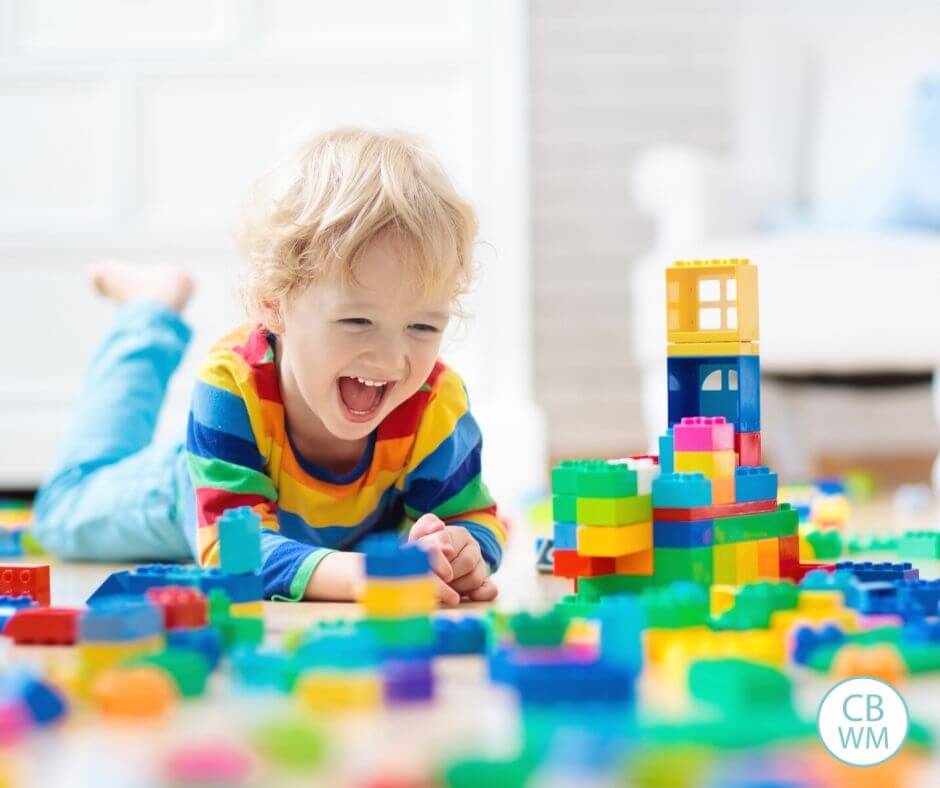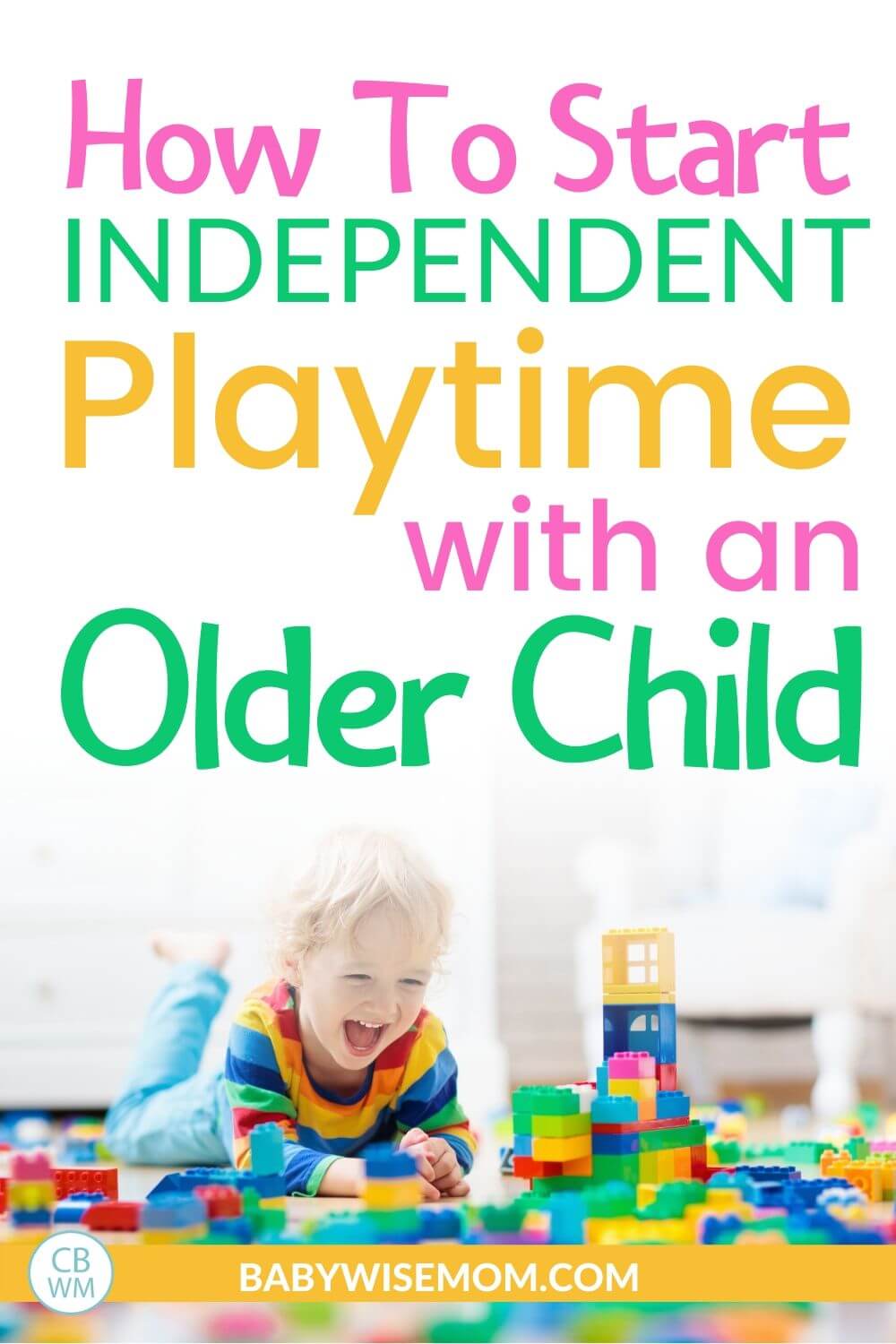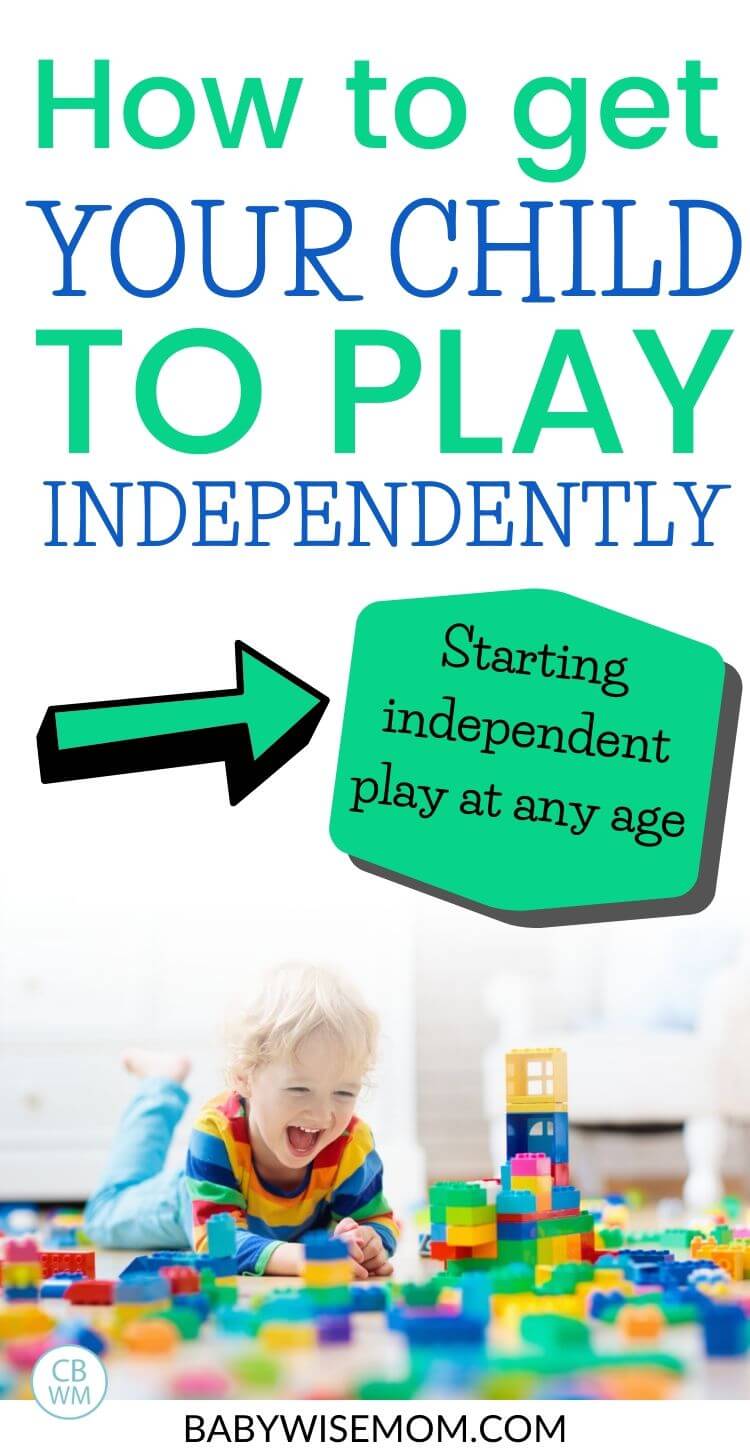Find helpful tips on how to start independent playtime with your child no matter the age of your child. Know how to set things up, when to do it, and how long.

Did you know it is possible to have your child play independently each day?
As in, alone?
Alone, without anyone else providing entertainment. Without an audience. Without instruction.
There are so many benefits to having your child play independently. Some benefits include:
- Mental Focusing Skills
- Sustained Attention Span
- Creativity
- Self-Play Adeptness
- Orderliness
Even with my four children now, we maintain independent play each day if we are home for an extended period of time. I find we all need time alone for a period of the day.
Post Contents
- Preparing to Start Independent Playtime Late
- Pick Your Ideal Time
- Choose The Ideal Location
- Prepare the Play Space
- Getting Started With Independent Playtime with an Older Kiddo
- If Your Child is Happy With Independent Play…
- If Your Child is NOT Happy With Independent Play…
- Starting Roomtime
- Starting Playpen Time
- Use Phrasing Wisely
- Good Tips to Keep Things Smooth
- For Older Children
- Related Posts on Independent Playtime
Preparing to Start Independent Playtime Late
You ideally start independent playtime with your baby. It is easier and smoother to implement with a baby because you can make it a normal part of life. I did that with my three girls and it was quite smooth.
Read: How To Get Your Baby Playing Independently
But life isn’t always ideal. You might not have known about independent play when your little one was a baby. Maybe you knew but didn’t have the capacity to try to implement it. Perhaps you knew but didn’t see a need since baby napped so much each day.
For whatever reason, now you know, and now you want to get started.
I didn’t get started with independent play until my oldest was 13 months old. This is how we successfully started late.

Pick Your Ideal Time
The first step is to choose your time of day.
I liked mornings when my kids were babies, toddlers, and preschoolers. Since they have all become school-aged, we like it in the afternoon. It gives everyone a mid-day break from each other.
Choose a time of day you know you can be consistent. I find that I am home in the morning hours most days. Consistency is such an integral part of success with independent playtime, so choose a time you know you can stick with it.
Choose a time of day your child will not be grumpy. You also want your child to be well-rested and not hungry. If your child is too tired or too hungry to be happy when you leave him alone, you will have a hard time starting independent playtime. You also want to prevent your little one from falling asleep during independent play and ruining nap time.
One tip, if you have more than one child and will be doing sibling play, I find independent play to work best if done before sibling play. Then they go from playing alone to playing with siblings rather than the other way around.
Read: Structured Playtime with Siblings (Sibling Playtime)
Choose The Ideal Location
Exactly where independent playtime will happen will depend on your child’s age and maturity level.
Any child under 12 months old who can move on their own at all (even by rolling) should be in a playpen.
Most children stay in the playpen until at least 18 months old, though some (like two of mine) move to room time earlier than that.
Most children two and older can handle being in a room instead of a playpen; however, if you are just starting IP, you might need to start with the playpen first until the child can do that happily, then move on to the room.
Here are some location ideas based on age:
0-3 Months
I do IP at the floor gym or on a blanket. I stay in the room with the baby, but don’t interact at all. Since they can’t really see far and don’t look around the room, they don’t really realize you are there.
3-6 Months
During this time period, you will want to transition to the playpen at some point. Feel it out with your child. I would say by 4 or 5 months, you want to be in the playpen at least some days. If your child doesn’t roll or move at all, you can still do days on a blanket so long as you are in the room supervising.
6-12 Months
Stay in the playpen during this age range.
12-15 Months
I think it is best for most to stay in the playpen. Kaitlyn moved out at 12 months, but not only is she incredibly mature for her age (was and is), her room was really not much larger than a playpen, anyway.
15-18 Months
This age range has a lot of variability. The -wise books suggest the child is still in the playpen at this age. But if you feel your child is able to handle roomtime, go for it. If your child is content in the playpen, stick with it.
18 Months-2 Years
Most will transition to roomtime sometime during this 6 month period
2 Years or Older
Room time for most. Some younger two year olds might still need the playpen.
Playpen
Now, if your child is in a playpen, move the playpen into a room where he/she cannot see you. Kaitlyn did it in my room. McKenna’s playpen was in her room, as was Brinley’s.
Like one of the -wise books says (I think it is Babywise II), it is not fair to expect a child to play on her own in the playpen if she can see you.
Room
If your child is ready for roomtime, it can be in any room so long as the room is safe. It can be a bedroom, den, family room, toy room…
Prepare the Play Space
Once you have chosen your ideal time of day and your ideal location, it is time to set the stage well.
If your child is in a playpen:
- Add toys and books to the playpen. Not too many and not too little.
- I like to leave the child with a sippy cup of water if they are old enough to hold it and drink from it alone.
- I like to play children’s hymns. This isn’t necessary.
If your child is in a room:
- Make sure it is safe. I think the best way to do this is to sit in the room with your child while she plays. Observe what she does. Remove dangers.
- Again, I leave a sippy of water.
- I play children’s hymns or toddler tunes.
- Make sure there are age appropriate toys available.
Read: Great Toys to Encourage Independent Playtime
Getting Started With Independent Playtime with an Older Kiddo
So you have your time of day chosen. You have your space prepared and ready. Now it is time to get started.
If Your Child is Happy With Independent Play…
Use a timer for independent playtime. It will help you know how long it has been and it will help your child learn that it ends when the timer goes off.
If your child is easy going and will play some on her own, start with 5-10, maybe even 15, minutes of you leaving her to play alone.
As she gets used to it, move the time longer by 5 minutes every few days. See Independent Playtime Lengths to know how long to strive for, based on your child’s age and ability.
If Your Child is NOT Happy With Independent Play…
If your child is resistant to IP, you are going to have to take things more slowly.
Our history is outlined in more detail in the posts Independent Playtime and Resistance to Independent Playtime, but basically, with Brayden, we did independent playtime with him as a baby for a bit, then stopped.
We then started up again at 13/14 months.
I started by playing with Brayden in his toy room at the designated time each day for 1-2 weeks.
Over time, I started removing myself more. I played less with him, but stayed on the floor.
I eventually moved up onto the twin bed that was in the room.
Then I would lay on the bed (I was in my first trimester with Kaitlyn, so this was great).
After a month or two, I started to leave him in the room alone. We started with 10 minutes. Then went up to 15. Then 20, etc.
Starting Roomtime
A great thing about me being in there with him was that I was able to observe him and make the room safe and also instruct him on what was and wasn’t okay.
We started with Roomtime since I was able to observe him and make the space safe from the beginning, but you might prefer to start in a playpen (and might need to).
See how we set up our roomtime at our house in this post.
Read: Roomtime–Your invitation
Starting Playpen Time
You might be able to do something similar to what I did with Brayden even when using the playpen.
However, since the child is safe in a playpen, since a child in a playpen will be younger, and since leaning over a playpen playing for two weeks doesn’t sound that comfortable, you might just want to go cold turkey.
In this instance, you would put he child in the playpen, set a timer for 5 minutes, cheerfully say good-bye, leave, then come back after the timer goes off.
Return cheerfully.
As your child gets used to this amount of time, gradually increase it. You might want to start IP off with showing her all of the fun toys to play with.
Use Phrasing Wisely
When you put your child in the playpen or in the room, say something like “okay, have a fun independent playtime! I love you!” Be positive. Do not apologize or act sad.
Then when you get your child out, no matter if he is happy or sad, say something like, “Hi honey! Did you have fun? Let’s clean up!” and be cheerful about it all. Don’t rush to console. Act like he has nothing to be upset over.

Good Tips to Keep Things Smooth
- Stay Consistent!
- Rotate Toys
- Keep toys age appropriate.
- At the end of independent playtime, have your child help clean up as best she can. At the very least, clean up in front of her so she sees how it is done.
- Stay postitive
For Older Children
If you have a school-aged child who doesn’t play alone but you are wanting to start now, get a timer or set an alarm and tell your child to go into his/her room and play alone until the timer or alarm goes off.
Then stick with it. If your child whines about being bored, express that you have confidence your child will be able to figure something out. Also express that it is okay to be bored.
Stay consistent with expectations and have consequences if expectations are not met and you will have success soon.
Related Posts on Independent Playtime
- Independent Playtime for the School-Aged Child
- What To Do When Your Child Falls Asleep During Independent Playtime
- Independent Playtime: The Ultimate Overview
- How To Get Your Child to Happily Play Alone
- How Independent Playtime Saved Our Homeschool
- What To Do When Your Kid Resists Independent Playtime
- What to Do When Your Child Falls Asleep During Independent Playtime
- When Your Child Won’t Stay in Independent Playtime
- Ransacking During Independent Playtime
- 10 Tips for Using The Timer That will Make Parenting Easier
- Benefits of Independent Play
- In Action: Love of Independent Playtime
This post originally appeared on this blog October of 2010
